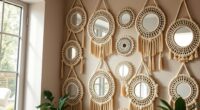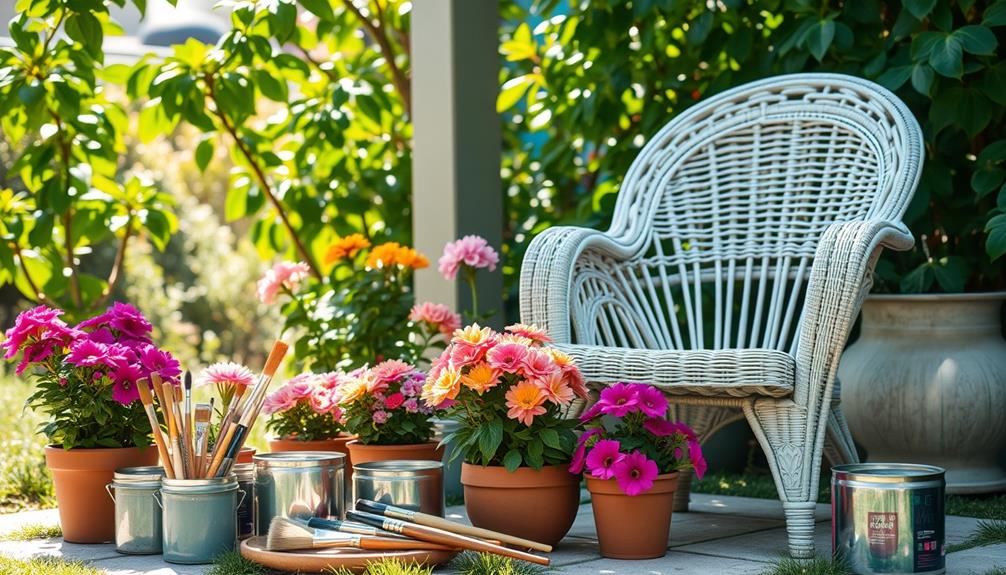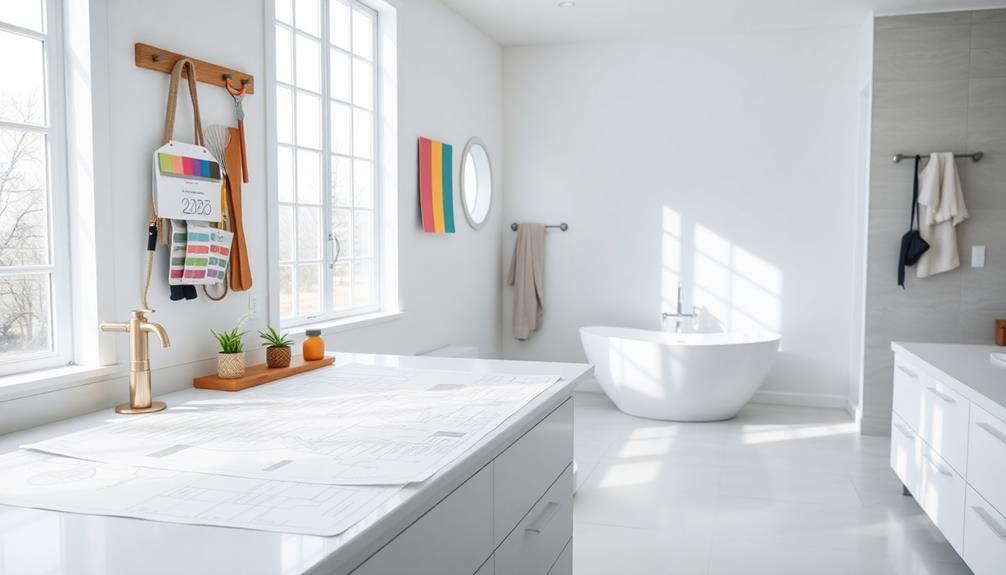Avoid common interior design mistakes by paying attention to scale, clutter, and color harmony. Choose furniture that fits your space without overwhelming it, and create a balanced color palette with natural tones and accents. Improve lighting with layered sources to add depth and highlight focal points like artwork or fireplaces. Incorporate personal touches and textures for warmth, but don’t overdo patterns. Good layout and smart storage help keep your space organized. Keep these tips in mind to transform your home—more insights await if you continue exploring.
Key Takeaways
- Avoid improper scale and proportion by measuring space carefully and selecting furniture that complements room size.
- Use a cohesive, limited color palette with thoughtful lighting to enhance harmony and set the desired mood.
- Incorporate layered lighting and focal points to add depth, interest, and visual balance to the space.
- Create style cohesion by choosing a unifying theme and avoiding mismatched decor and incompatible styles.
- Personalize your space with meaningful textures and sentimental items to add warmth and character while balancing patterns and textures.
Ignoring Scale and Proportion
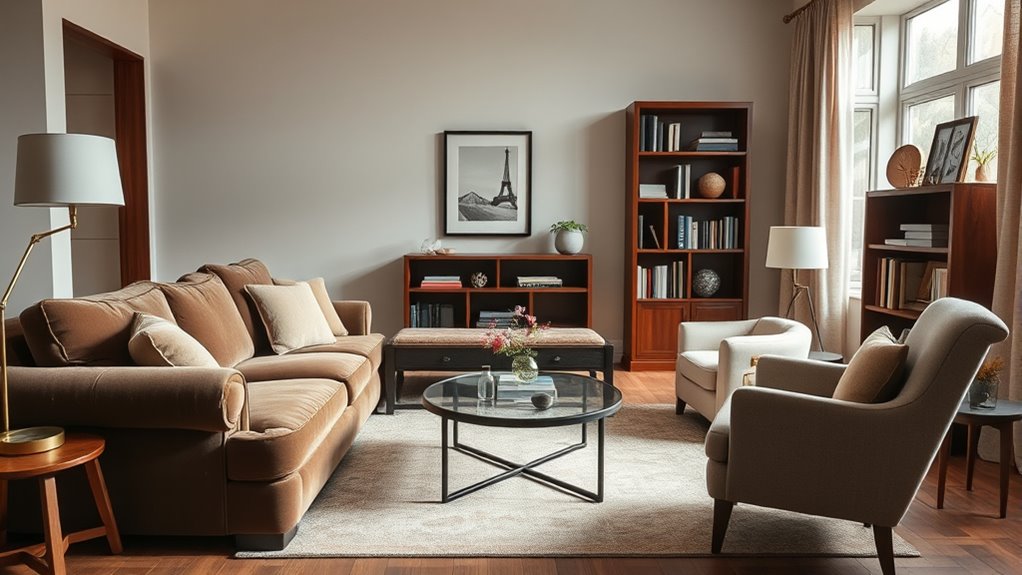
Ignoring scale and proportion can quickly make a room feel off-balance and uncomfortable. When furniture and decor lack scale harmony, the space may seem awkward or cluttered. Achieving proportion balance means selecting pieces that complement each other in size and visual weight, creating a cohesive flow. Large furniture in a small room can dominate, while tiny accessories might get lost in a spacious area. To fix this, measure your space and choose items that fit comfortably without overwhelming or shrinking the room’s natural flow. Consider how each piece relates to others, ensuring a visual balance. Proper scale harmony and proportion balance help your room feel inviting, harmonious, and well-designed, rather than chaotic or awkward. Incorporating natural materials such as wood, stone, and linen can also enhance the rustic charm and ensure your decor feels authentic and balanced. Paying attention to visual weight and how different elements interact can further improve the overall harmony of your interior. Additionally, understanding proportion helps in selecting artwork and accessories that complement the space without overpowering it.
Overcrowding the Space
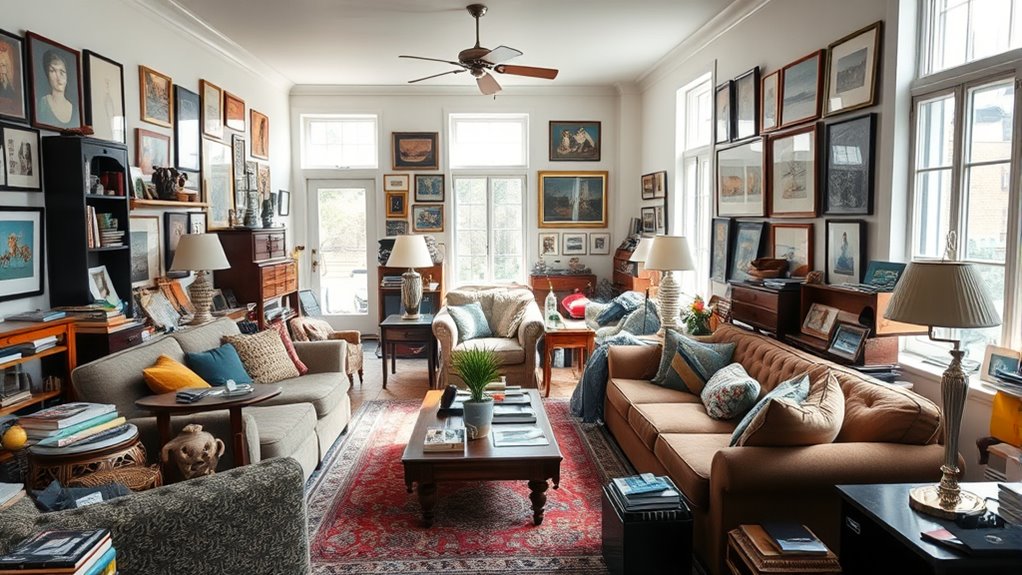
When your space feels cluttered, start by optimizing your furniture arrangement to create open pathways. Prioritize essential items and remove unnecessary pieces to reduce overcrowding. Additionally, use vertical storage solutions to maximize space without sacrificing style. Incorporating vertical storage solutions can also enhance the overall harmony and prevent visual clutter. Regularly assessing and rotating items helps maintain an organized environment and prevents clutter from accumulating over time.
Optimize Furniture Arrangement
Overcrowding a room with too much furniture makes the space feel cramped and uncomfortable. To optimize furniture arrangement, focus on effective space planning and maintaining good furniture flow. Here are four tips to help you:
- Clear pathways: Leave enough space between furniture pieces so you can move easily without obstruction.
- Prioritize function: Arrange essential items where they’re most accessible, reducing clutter.
- Create focal points: Position larger furniture to highlight a feature, like a fireplace or window.
- Use scale wisely: Choose appropriately sized furniture to fit the room without overwhelming it. Additionally, understanding space planning principles can help create a balanced and inviting environment.
Prioritize Essential Items
Focusing on the items you use most often can make a big difference in avoiding clutter and creating a more functional space. Prioritize essential needs by keeping only the items that serve a clear purpose in your daily life. Avoid filling your space with decorations or furniture that don’t support your functional priorities. Instead, allocate space for essentials like everyday kitchen tools, clothing, or work materials. This approach promotes better space utilization and helps maintain an organized environment. By consciously selecting what truly matters, you’ll free up room and make your space easier to navigate. Remember, less is often more. Keeping only the essentials ensures your home remains practical, comfortable, and visually appealing without feeling cluttered or overwhelming. Additionally, practicing dynamic communication exercises with household members can improve understanding and help set clear priorities for space management, especially during busy shopping hours or holiday seasons.
Use Vertical Storage
Have you considered how vertical storage can transform your space? Overcrowding happens when you ignore vertical options, making rooms feel cluttered. To avoid this, try:
- Installing wall mounted shelving to keep items off surfaces and utilize wall space.
- Incorporating hidden vertical cabinets that blend seamlessly into your walls, providing extra storage without crowding.
- Using tall, slim storage units to maximize height without taking up much floor space.
- Hanging hooks or racks on walls for frequently used items, freeing up drawers and counters.
- Consider TikTok trends for innovative storage ideas that can be both stylish and functional.
- Exploring projector placement options to optimize viewing experiences and prevent clutter by keeping equipment organized and out of sight.
- Utilizing vertical storage solutions to make the most of limited space and maintain an organized and open environment.
Choosing the Wrong Color Palette
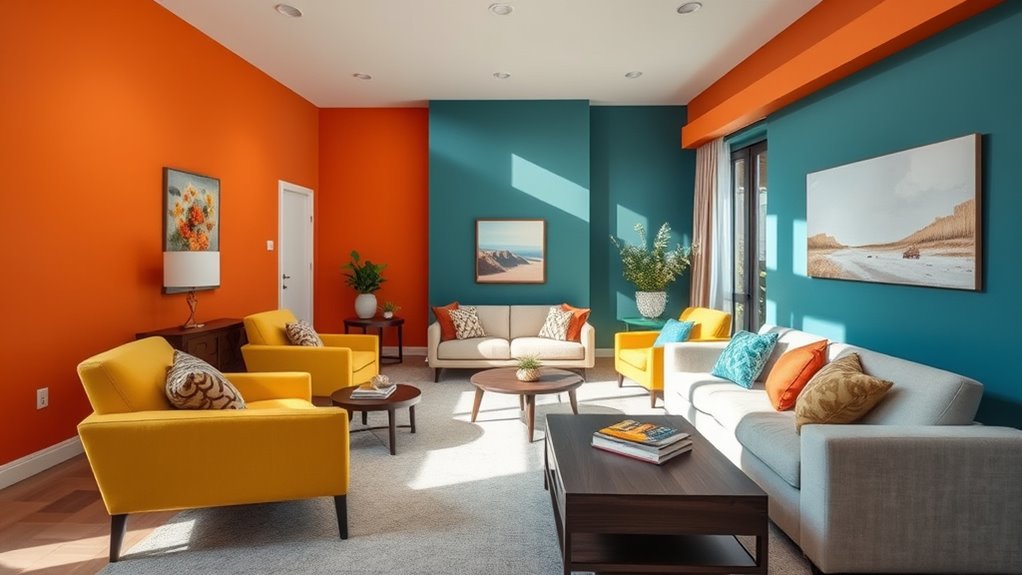
Choosing the wrong color palette can quickly make your space feel chaotic or uninviting. Overwhelming choices, clashing shades, and tones that don’t complement each other can ruin the look. Poor lighting can also distort colors and undermine your design effort. Embracing a well-considered color harmony can help you select harmonious colors and create a balanced atmosphere. Additionally, understanding the psychological effects of colors can guide you in creating a space that evokes the desired mood and energy.
Overwhelming Color Choices
Selecting the wrong color palette can quickly turn a beautiful space into a visual headache. When your palette lacks harmony, your room feels chaotic instead of inviting. To avoid this, focus on these tips:
- Limit your color choices to 2-3 main shades for balance.
- Use a color wheel to find complementary or analogous colors for better color harmony.
- Test paint samples in different lighting to see how they interact.
- Choose a neutral base to anchor bold accent colors, preventing overwhelming contrasts.
- Consider interior design principles to create a cohesive and aesthetically pleasing environment.
- Incorporating color psychology can also help select hues that evoke the desired mood in your space.
Clashing Shades and Tones
When your color choices clash instead of complementing each other, the result can feel disorganized and jarring. Achieving color harmony is essential to create a cohesive space. Focus on shade coordination by selecting colors within the same color family or those that share undertones. Avoid mixing overly vibrant hues with muted tones unless intentionally balanced. Use a color wheel as a guide to pair complementary or analogous shades that naturally work well together. Stick to a limited palette to prevent visual chaos, and introduce accent colors sparingly to add interest without overwhelming the senses. When your color palette feels balanced and thoughtfully chosen, your space will look more unified and inviting. Proper shade coordination transforms a chaotic mix into a harmonious design. Incorporating soft color palettes and natural elements inspired by farmhouse decor can further elevate the calming ambiance of your space. Additionally, understanding color psychology can help you select hues that evoke the desired mood and atmosphere in your interiors. Exploring emotional impact of colors allows you to tailor your choices to enhance the overall feel of your environment.
Poor Lighting Impact
Poor lighting can dramatically alter how colors appear in a space, often making even well-chosen palettes look dull or unappealing. Natural light and artificial lighting influence how your colors are perceived, so mismatched lighting can distort your design. To fix this:
- Use daylight bulbs that mimic natural light for consistent color rendering.
- Incorporate layered lighting—ambient, task, and accent—to balance the space.
- Position lights to highlight your true color choices, avoiding shadows that mute hues.
- Choose a color palette that works well under both natural and artificial lighting conditions.
- Considering lighting’s impact on perception can help you select the most flattering colors for your space. Additionally, understanding how automation in business can improve lighting control systems may help you create a warm and inviting environment.
Neglecting Lighting Layers
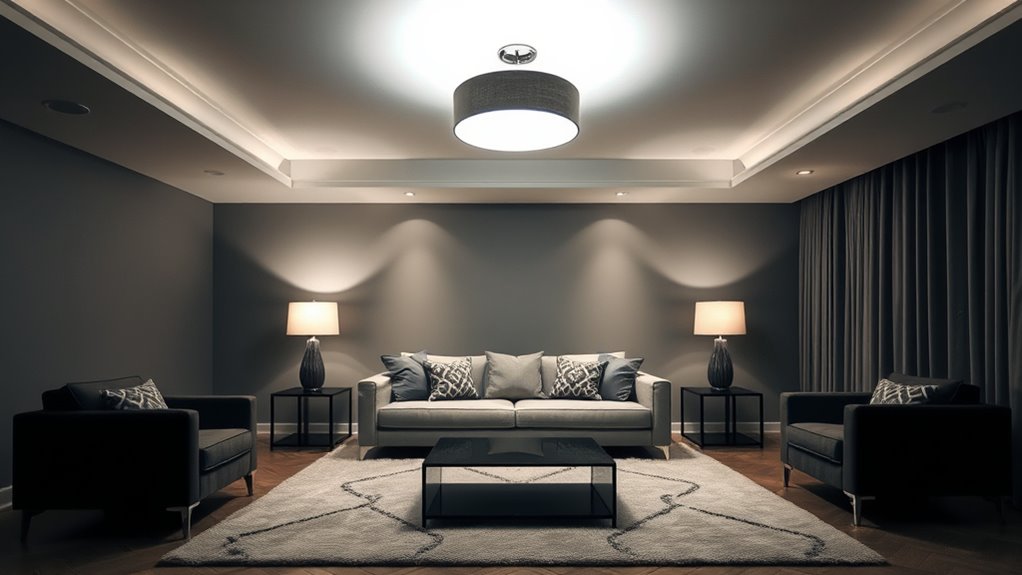
Neglecting lighting layers can make a space feel flat and uninviting, even if the design and furnishings are perfect. Without proper ambient lighting, your room lacks warmth and atmosphere. Layered illumination combines different light sources—overhead fixtures, task lighting, and accent lights—creating depth and visual interest. When you skip this, your space may appear dull or overly harsh. Incorporate ambient lighting to set the overall mood, then add task lights where needed, like reading lamps or under-cabinet lights. Accent lighting highlights artwork or architectural features, enhancing the room’s character. By paying attention to lighting layers, you ensure your space feels welcoming, functional, and visually balanced. Proper layered illumination transforms a simple room into a well-designed, inviting environment. Additionally, understanding the role of AI in design can help you incorporate smart lighting solutions for more dynamic control and energy efficiency.
Failing to Establish a Focal Point
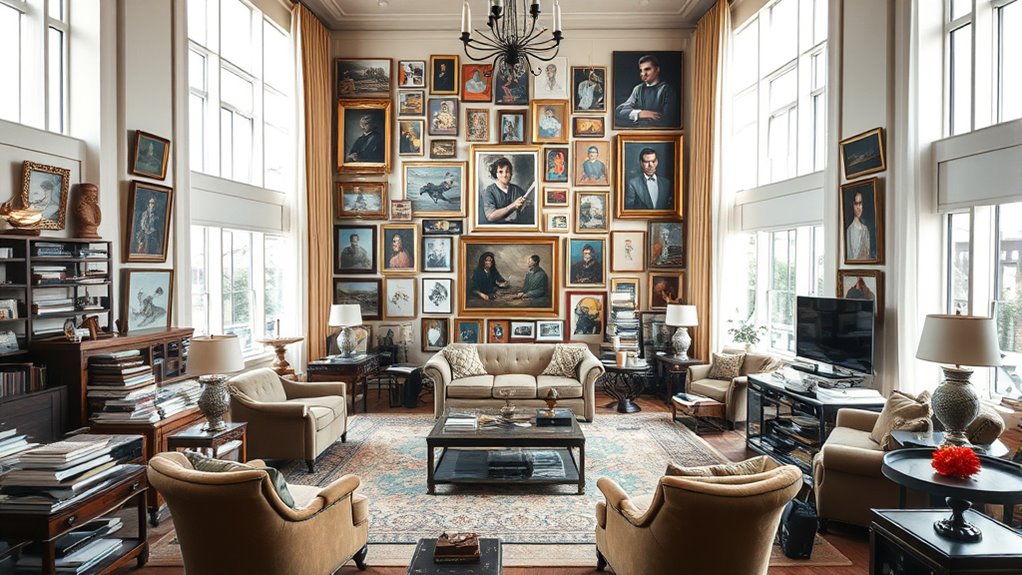
Have you ever entered a room and felt it lacked impact or direction? That’s often because there’s no focal point, which highlights the significance of designing to draw attention. Without a clear focal point, your space can feel flat and uninviting. To fix this:
- Choose a statement piece, like a bold artwork or an eye-catching fireplace.
- Use lighting to highlight your focal area.
- Arrange furniture to naturally direct the eye toward the focal point.
- Incorporate contrasting colors or textures to make it stand out.
Creating a focal point is essential because it guides your eye and makes the room feel intentional. When you design to draw attention to a specific spot, your space instantly becomes more engaging and balanced.
Inconsistent Style and Theme
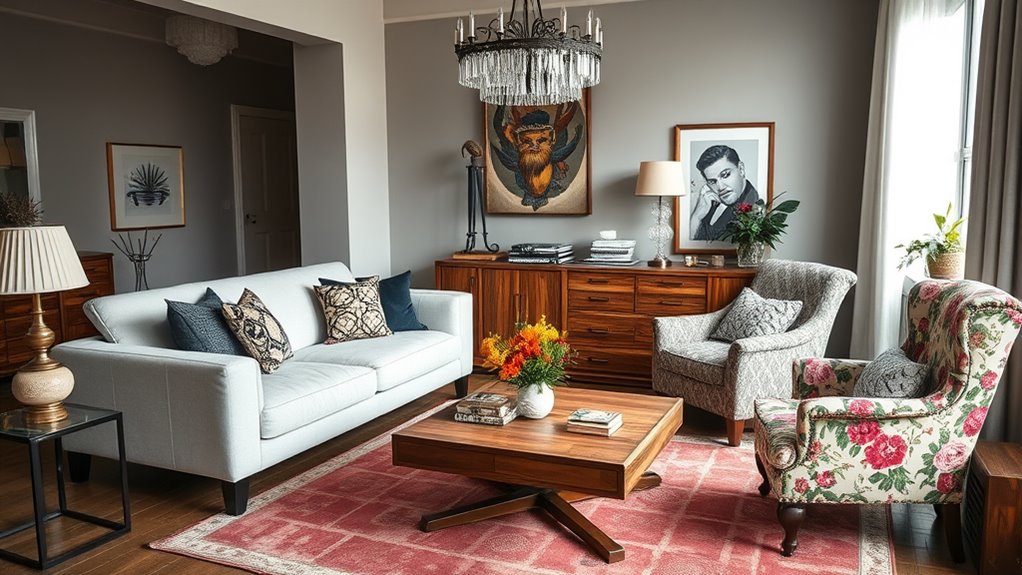
When your decor incorporates a mix of incompatible styles and themes, it can make your space feel chaotic and disjointed. To fix this, focus on creating a cohesive decor by choosing a unifying style or theme. Avoid cluttering your space with matching accessories that clash or seem out of place. Instead, select items that complement the overall look and feel of your room. Consistency in furniture, color palette, and decorative elements helps tie everything together, making your space feel intentional and harmonious. If you’re mixing styles, do so thoughtfully by balancing contrasting elements with common colors or materials. This approach assures your decor looks curated rather than random, resulting in a polished, unified environment.
Overusing Patterns and Textures
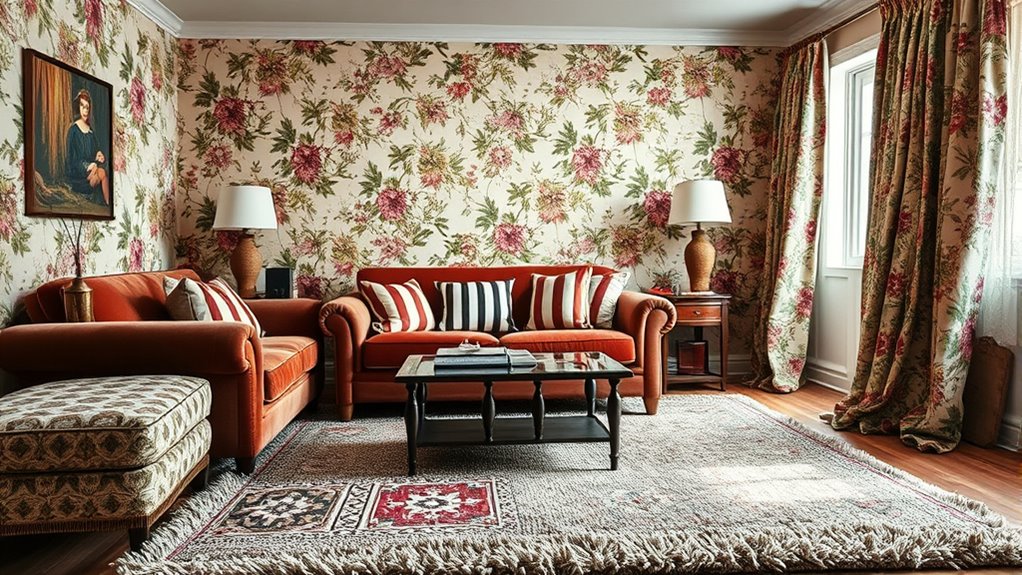
Using too many patterns and textures can make a space feel chaotic instead of stylish. To avoid this, you need to balance the scale of your patterns and choose textures that complement each other. When done right, it creates visual interest without overwhelming the room.
Balance Pattern Scale
Overusing patterns and textures can overwhelm a space and disrupt visual harmony. To achieve balance, focus on pattern scale and consistency. Here are key tips:
- Limit large-scale patterns to one or two focal areas to prevent visual clutter.
- Mix small, subtle patterns with bold ones to maintain scale harmony.
- Keep pattern repetition consistent throughout the room for pattern cohesion.
- Use neutral backgrounds to let patterned pieces stand out without overwhelming the eye.
Mix Textures Wisely
While mixing textures can add depth and visual interest to a room, overdoing it can create a chaotic and overwhelming environment. To avoid this, focus on achieving proper textural contrast without sacrificing tactile balance. Use a variety of textures strategically—combine smooth surfaces with rough or soft fabrics—so each element complements the others. Don’t layer too many patterns or textures simultaneously, which can distract or confuse the eye. Instead, highlight one or two key textures as focal points, and keep the rest subdued. This approach maintains harmony in your space while adding visual interest. Remember, the goal is to create a balanced mix that invites touch and feel, not a jumble of competing elements. Thoughtful textural contrast enhances your room’s character without overwhelming it.
Poor Furniture Placement
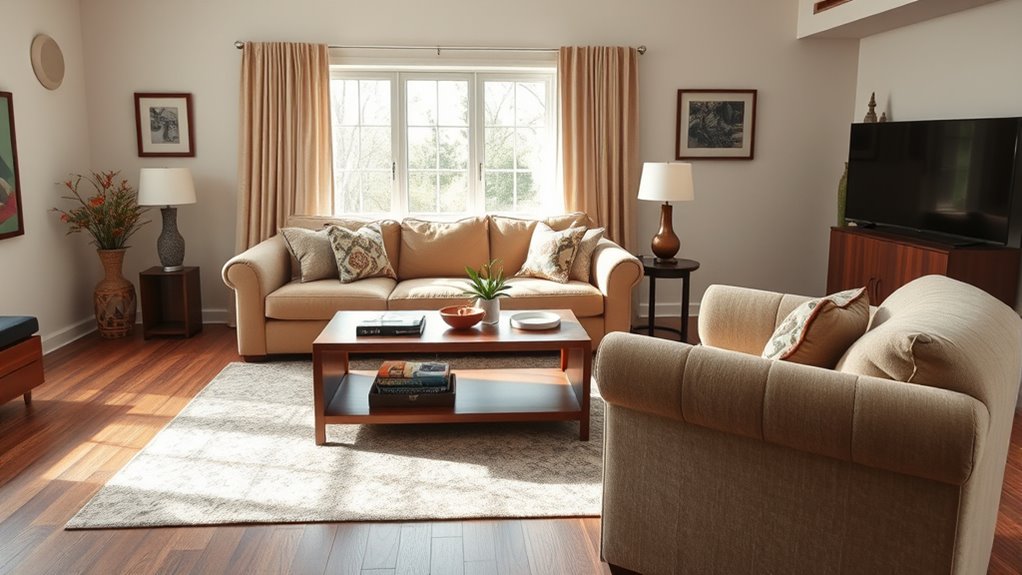
Poor furniture placement can quickly make a room feel cramped or unbalanced, even if the pieces themselves are stylish. To avoid this, consider how your layout supports artistic expression and reflects cultural influences. Here are some tips:
Effective furniture placement fosters harmony, cultural expression, and inviting atmosphere in any room.
- Arrange furniture to create clear pathways, promoting flow and openness.
- Place key pieces—like sofas and tables—where they encourage conversation and functionality.
- Use symmetry or asymmetry intentionally to highlight your cultural influences.
- Avoid blocking windows or focal points, ensuring natural light and view are preserved.
Proper placement enhances your space’s harmony and allows your personality and cultural stories to shine through. When furniture is thoughtfully arranged, it transforms a room from cluttered to inviting, supporting both comfort and artistic expression.
Skimping on Storage Solutions
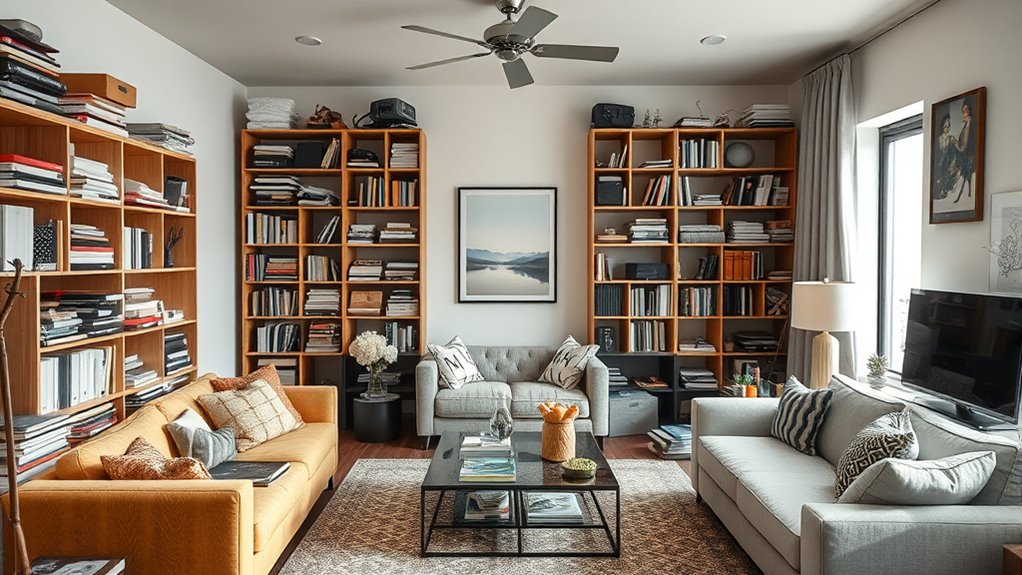
Careful furniture placement can make a room feel open and inviting, but neglecting adequate storage can quickly undo that harmony. Skimping on storage solutions leads to clutter and chaos, undermining your design efforts. Instead, incorporate hidden storage options—like built-in cabinets or under-bed drawers—that keep belongings out of sight without sacrificing style. Multifunctional furniture is a smart choice; ottomans with storage, beds with drawers, or coffee tables with compartments maximize space and functionality. These solutions help maintain a clean, organized look while reducing visual clutter. Don’t overlook storage as an afterthought. Thoughtfully integrating hidden storage and multifunctional pieces ensures your space remains both beautiful and practical, making your home more comfortable and easier to maintain.
Forgetting Personal Touches
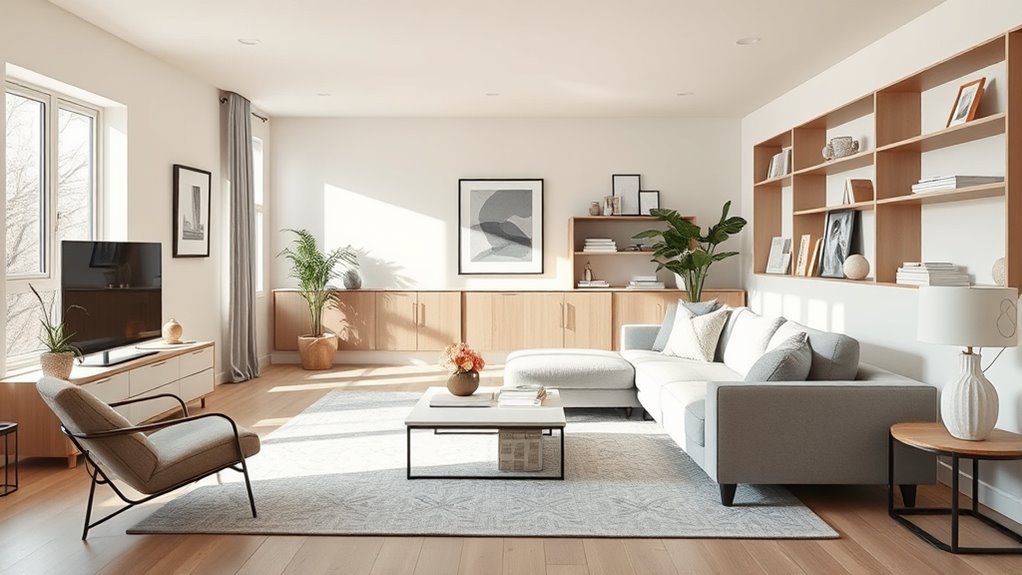
Adding personal touches to your interior design is essential for creating a space that truly feels like home. Without sentimental decor, your room can lack warmth and personality. To fix this, consider these ideas:
Personal touches make your space warm, authentic, and uniquely yours.
- Display photos of loved ones or memorable moments.
- Incorporate heirlooms or favorite keepsakes.
- Use artwork or decor that reflects your hobbies and interests.
- Add textiles like throw pillows or blankets with meaningful patterns or colors.
These personal touches make your space uniquely yours and foster emotional comfort. Sentimental decor adds depth and authenticity, preventing your home from feeling generic or impersonal. Remember, your environment should tell your story, so don’t hesitate to showcase what matters most to you. Small, meaningful details can transform a bland room into a cozy, inviting haven.
Frequently Asked Questions
How Can I Balance Multiple Design Styles in One Space?
To balance multiple design styles in one space, start with a cohesive color palette to create harmony. Use color harmony to tie different styles together and avoid visual chaos. Focus on furniture coordination by selecting pieces that complement each other, blending elements from each style seamlessly. Incorporate neutral tones or consistent accents to unify the look, making diverse styles feel intentional and well-curated rather than mismatched.
What Are Effective Ways to Make Small Rooms Appear Larger?
Think of your small room as a canvas waiting to expand. Use color illusions by opting for light, neutral shades to reflect more light and create a sense of space. Incorporate multi-functional furniture to maximize functionality without clutter, like a sofa bed or storage ottoman. Keep the space open and uncluttered, and add mirrors to bounce light around. These tricks help your room feel larger and more inviting.
How Do I Choose the Right Lighting for Different Activities?
To select the right lighting for different activities, start with ambient lighting to set a comfortable overall glow. Add task lighting where you need focused light, like for reading or cooking. Consider adjustable options like dimmer switches to customize brightness for each activity. Combining ambient and task lighting guarantees your space is functional and inviting, tailored to your needs, whether you’re relaxing, working, or entertaining.
What Are Simple Tips to Create a Cohesive Interior Theme?
To create a cohesive interior theme, focus on color coordination by choosing a consistent palette that flows throughout your space. Pay attention to furniture placement, ensuring each piece complements the overall style and layout. Mix textures and patterns thoughtfully, and keep accessories minimal to avoid clutter. By balancing these elements, you’ll craft a unified look that feels intentional and inviting, making your home truly reflect your personal style.
How Can I Incorporate Personal Items Without Cluttering?
Did you know that 60% of people struggle with displaying personal items without clutter? To achieve this, focus on intentional personal item display by choosing a few meaningful pieces. Use stylish storage solutions, like baskets or shelves, to prevent clutter. Rotating items seasonally keeps your space fresh, while grouping similar objects creates a tidy, curated look. This way, your personal touches shine without overwhelming your room.
Conclusion
By avoiding these common mistakes, you’ll transform your space from a chaotic disaster into a stunning sanctuary that even your neighbor’s jaw will drop at! Get your scale right, choose perfect colors, and don’t forget those cozy lighting layers. Remember, a well-designed room isn’t just pretty—it’s your personal oasis where every detail works. So, fix these blunders, and watch your home become the masterpiece you’ve always dreamed of—no more design disasters, only dazzling perfection!

